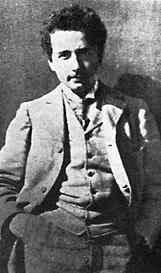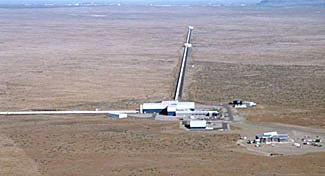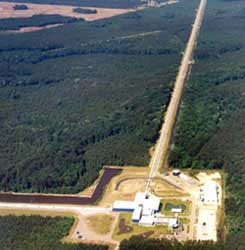![]()
![]()
While it is likely humans have always been aware of gravity, understanding of gravity has long been vague and inaccurate. Aristotle and his followers believed that everything had by nature a place where it belonged with respect to the center of the earth (the center of the universe). An object away from its natural place would try to return to where it belonged. An object would fall at a speed proportional to its weight, and that speed would increase as the body was released further from its natural place. Aristotle also proposed a method of science consisting of an experimental and rational process beginning with a real problem and proceeding from known facts to a solution. The solution must be found within the context of the problem and not introduced extraneously.
Aristotle's followers had difficulty explaining why a projectile did not immediately begin to fall the moment after release. In 1319-1320 Francis de Marchia in Paris proposed a power
he called impetus, impressed on a body by the thrower, which would carry the body but slowly dissipate, finally leaving the body free to fall. Within a decade Thomas Bradwardine (1295-1349), later the Archbishop of Canterbury, wrote an influential Treatise on the Proportion of Velocities in Moving Bodies in which he established that motion should not be thought of as a process of a body
but the mathematical proportion of distance/time. A best-seller of the fourteenth century, it was soon part of many university courses. Treating motion as a subject for measurement was a critical step for understanding gravity.
Galileo Galilei (1564 -1642) accurately described motion, noting that falling bodies here on earth all have the same uniform acceleration. Isaac Newton (1642-1727), said he stood on the shoulders of giants to develop the Law of Universal Gravity. At age of 23, Newton stayed on a family farm in Lincolnshire to avoid the 1665 Great Plague in London. Legend claims that Newton's observations of falling apples led him to consider gravity extending to the orb of the Moon and to compare the two accelerations. Comparing the ratios of accelerations (apple/Moon = 3640) with the ratios of their two distances (Moon orb/earth radius = 60.1), Newton noted that the first is almost exactly the square of the other. Thus he had discovered that the force of gravity decreases as the inverse square of the distance. Newton identified gravity to be due to mass, but claimed no theory of how gravity could act across great distances.
In 1915 Albert Einstein (1879-1955 shown at right) amplified Newton's gravity, concluding that our world is not Euclidean, but rather that geometry is shaped by masses and their velocities as described by the mathematics of General Relativity. That is to say, space-time curves near masses. In General Relativity gravitational mass is fundamentally identical to mass measured as inertia. Newtonian gravity becomes a special case which adequately describes situations involving relatively weak gravity. But the differences become noticeable when masses are very large and the distances small. Previously observed slow rotation of Mercury's elliptical orbit round the sun agreed with Einstein's General Relativity but was not measured precisely enough to be considered a firm verification of the theory. In 1919 Arthur Eddington announced he had verified Einstein's prediction of attraction of starlight passing near the surface of the sun, a measurement made possible by a solar eclipse during an expedition to the equator near West Africa.
By the later part of the 19th Century, it was well established that waves and pulses are typically produced by vibrating (accelerated) bodies. Vibrating strings create sound waves and vibrating electric charges emits light waves. In 1916 Albert Einstein predicted based on General Relativity that vibrating (accelerated) masses should create gravitational waves. But because of the weak strength of gravity, only enormous masses undergoing huge accelerations would form gravitational waves with strong enough effects to be barely detectable. Gravity waves have not yet been detected directly. However the predicted influence of gravitational waves on a binary pulsar was measured by Joseph Taylor (1941- ) and Russel Hulse (1950- ) who were awarded the 1993 Nobel Prize in Physics for their work using the 300-m radiotelescope at Arecibo, Puerto Rico. In the situation they measured, two neutron stars, each with a radius of about ten kilometers but with a mass comparable with that of the Sun, and at short distance from each other of only several times the Moon's distance from the Earth, orbit each other in less than eight hours. A rapidly spinning neutron star emits two beams of radio waves along its magnetic axes. When the spin axis and magnetic axis are not identical, the radio beams are swept in two arches around the sky. If a beam path occasionally sweeps towards the Earth, a radio pulse can be detected, in this case with a period between pulses of 0.05903 sec. Thus the star which is composed exclusively of neutrons is called a pulsar. This pulse period would be extremely stable except the observed period actually varies by several tens of microseconds as result of a Doppler shift indicating that the neutron star orbits a binary partner. As the pulsar orbits closer to the earth, the pulses reach the earth more frequently; as it orbits away from earth the pulses arrive less frequently. From this variation in pulse period (a little less than 8 hours), their masses can be determined. Taylor and Hulse found an additional variation: The orbit period is declining by about 75 millionths of a second per year (less than 5% during 1 million years). These two stars are orbiting each other in a gradually smaller (therefore faster) orbit. The explanation is that these two massive stars are strongly accelerated by their circular orbits and thus required to lose energy in the form of gravity waves as predicted by general relativity. The Nobel Prize recognizes this first indirect verification of gravity waves.
It is believed that current technology now enables the direct detection of gravity waves. Gravitational waves are ripples in the fabric of space and time produced by violent events in the distant universe, such as the collision of two black holes or shockwaves from the cores of supernova explosions. Such gravity waves could bring with them information about their cataclysmic origins, as well as invaluable clues as to the nature of gravity.
The Laser Interferometer Gravitational-Wave Observatory (LIGO) is a set of facilities designed using cutting edge technology to detection and measure gravitational waves from very distance sources. It consists of two widely separated installations at Hanford, WA, and Livingston, LA, operated in unison as a single observatory. The larger the detector, the more sensitive it can be. Each employs 4-foot diameter vacuum pipes arranged in the shape of an L with 4-kilometer (2.5-mile) arms. Since gravitational waves can pass right through earth, these pipes need not be exposed to the sky. They are covered by concrete and located in remote areas to reduce other possible influences. Large masses with mirrored surfaces hang from wires at the corner of the L and at the end of each of its arms. These masses are the sensors of gravitational waves. Laser beams are reflected from the mirrors on the masses so that tiny changes in the distance between masses along the two arms of the L can be detected by an interference pattern of light. To detect the effects of gravity waves but eliminate all other possible causes for tiny motions, electronic signals from two or more vastly separated observatories are compared.
 LIGO at Hanford, WA |
 LIGO at Livingston, LA |
Gravitational waves are ripples in the fabric of space-time. When they pass through the L-shaped detectors they will decrease the distance between the hanging masses in one arm of the L, while increasing it in the other. These changes are tiny, 10-16 centimeters, (one-hundred-millionth the diameter of a Hydrogen atom). Such tiny changes can be detected only by isolating the test masses from disturbances, such as seismic vibrations of the earth and even those from gas molecules in the air. Then other local causes are discounted by comparing simultaneous results from detectors elsewhere.
LIGO has the possibility to test several of general relativity's predictions:As the observatory tests the initial design and does the first searches for gravity waves, part of the initial plans are underway to push the technology forward and improve the apparatus sensitivity by more than a factor of 10. Improved detectors designed to overcome any difficulties discovered by the current generation of detectors will replace the present detectors in the current facilities once it has reached its goal of a year of observation. It is anticipated that this advanced instrument might detect gravitational wave sources as often as daily, with excellent signal strengths, allowing details of the waveforms to be determined and compared with theories of neutron stars, black holes, and other highly relativistic objects.
Provision was launched February 15, 2005 to allow many people with home or business computers to contribute to the project by donating their computers when not otherwise being fully used to search the data for patterns. This process known as distributed computing has been previously used for a small number of research projects requiring large amounts of computer processing. Recorded data from widely separated detectors will be compared searching for a wide diversity of mass motions and durations. Findings are reported back to the experimenters after the data has been analyzed and a new set of data downloaded for analysis. If you are interested in contributing to this science, the necessary procedure follows in #4.
Communicating technical information such as observations and findings is a skill used by scientists but useful for most others. If you need course credit, use your observations in your journal to construct a formal report.
![]()
next Experiment
to ie-physics menu
to site menu